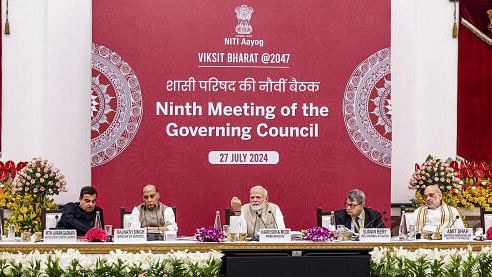
Prime Minister Narendra Modi, Union Home Minister Amit Shah, Union Defence Minister Rajnath Singh and others during the NITI Aayog Governing Council meeting, in New Delhi.
Credit: PTI Photo
In the 9th Governing Council meeting of NITI Aayog chaired by Prime Minister Narendra Modi last month, an approach paper on the vision to make India a developed nation was discussed. In around a month the government is likely to come out with a vision document for Viksit Bharat by 2047, when India completes 100 years since Independence.
The approach paper underlines that India has made significant strides in most socio-economic spheres in the last seven decades and now is at a “turning point” in its journey for development.
“By 2047, India is capable of becoming a $30 trillion economy with the quality of life of a developed nation. It will be a Viksit Bharat,” the paper, prepared by NITI Aayog, underlined.
‘Viksit Bharat’ has been among the most widely used phrases by Prime Minister Narendra Modi’s government in the past couple of years. It was also extensively used during the campaign for the recent Lok Sabha elections.
The term ‘Viksit Bharat’ translates to ‘developed India’. What exactly does it mean to become a developed country? There is no exact definition or established convention for designating a country ‘developed’. However, international financial institutions classify countries based on per capita income, human development indicators, and social, technological, and institutional development.
The World Bank classifies countries in four groups based on income level. The countries with per capita of up to $1,145 are classified as low income. The countries having per capita income in the range of $1,146–$4,515 are classified as lower-middle income, $4,516–$14,005 as upper-middle income, and above $14,005 as high income.
Credit: DH Illustration
The International Monetary Fund (IMF) classifies countries into three groups – low-income developing countries, emerging market and middle-income economies, and advanced economies.
With a per capita income of $2,392, India is classified as a lower-middle income country as per the World Bank’s classification, while, as per the IMF, India is in the group of emerging markets and middle-income economies. One of the key criteria for being a developed country is to join the club of high-income countries. At present, the average annual income of Indians is just around one-sixth of the threshold for a high-income group.
The World Bank revises the income thresholds for the country classification periodically. It is adjusted annually for inflation using the Special Drawing Rights (SDR) deflator, which is a weighted average of the GDP deflators of China, Japan, the United Kingdom, the United States, and the Euro Area. The threshold for the high-income group was raised to $14,005 this year from $13,845 in the previous year. This threshold is bound to increase substantially by 2047 when India eyes to enter the high-income country category.
The per capita income depends on two factors – national income and population. India’s gross domestic product (GDP) stood at around $3.36 trillion in the financial year that ended March 2024. As per the NITI Aayog’s approach paper, India should strive to have a GDP of $30 trillion by 2047, nine times the current level. The per capita income is estimated to increase eight times to $18,000. An average annual GDP growth of around 10% would be required to achieve this target. An important factor in this will be rupee-dollar exchange rates.
Apart from the per capita income, other factors used to determine the level of development of a country include the level of industrialisation, the general standard of living, technological infrastructure, and the human development index, which measures several parameters like the level of education, health, and literacy.
The United Nations Development Programme (UNDP) classifies countries into four groups based on their Human Development Index (HDI) score – low, medium, high, and very high. With a score of 0.644, India is classified as a country with medium HDI. As per the latest HDI report released in March this year, India is placed at 134th position out of 193 countries.
Key dimensions of human development, as per the UNDP, are a long and healthy life, being knowledgeable, and having a decent standard of living. India has to travel a long distance on all these three dimensions to be categorised as a “developed” country.